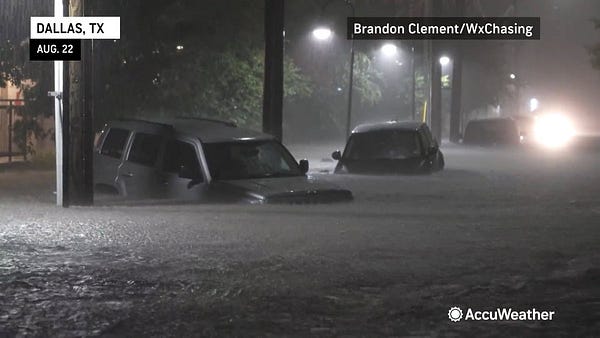Destabilized Saturday Edition #32
Miami real estate follow-up, even stupid questions have answers, "We can't live here anymore", and a Mar-a-Lago Netflix comedy pitch
As Though you wouldn’t know it from current real estate prices, Miami is acutely exposed to climate impacts. To help me, as much as anyone, find it in once place in the future, here’s a list of the factors that make Miami especially climate vulnerable:
Very low elevation, nearly the entire city is lower than 10 feet above sea level (“With just three feet of sea-level rise, more than a third of southern Florida will vanish”).
Miami sits on limestone, which is so porous water can come up through it from below, and thus renders sea walls ineffective (“Imagine Swiss cheese, and you’ll have a pretty good idea what the rock under southern Florida looks like”).
Exposure to Atlantic hurricanes, like Hurricane Andrew, which devastated the city, along with much of South Florida, in August 1992.
Unusually high concentration of real estate at low elevations along the coast.
Key nuclear energy facility, Turkey Point Nuclear Plant, sited on the edge of Biscayne Bay and exposed to storm and rising seas, which climate writer Jeff Goodell calls “as clear a picture of the insanity of modern life as I’ve ever seen.”
Drinking water sources at risk of salt water contamination.
Sewer treatment infrastructure that’s highly vulnerable to sea level rise and storms, including more than 100,000 septic tanks.
Less diversified economy (real estate, entertainment, hospitality), which is arguably more likely to see downward spiral-triggering population outflows after destructive weather events than other cities.
High levels of climate denial and wishful thinking, among both regular people and, especially, the state’s Republican leadership.
Zero percent income tax, and, more broadly, a low-tax, low investment ethic befitting a state whose executive and legislature have been fully Republican controlled since Jeb Bush was elected governor in 1998. Both the revenue magnitude and the mindset are the opposite of what’s needed to build physical resilience.
An already shaky home insurance market, which has problems that go beyond the inherent vulnerability of Florida homes to climate damage, and in which the state of Florida itself is now the insurer of last resort for those who can’t get policies written in the private markets.
The many ways these factors reinforce and amplify one other, including that higher sea levels mean a future hurricane’s storm surge will do more damage than if the same storm hit when sea levels were lower.
What’s missing from this list?
—
I love Miami, it feels like being in an enchanting, far away land. My wife and I actually toyed with the idea of moving there several years ago.
Rolling Stone climate journalist Jeff Goodell (quoted above) wrote the definitive Miami’s-climate-future article all the way back in 2013. It later became his book, The Water Will Come, which is excellent. In the article, Goodell speculates that if Miami tips into a downward spiral in the future, it might go something like this:
As insurance rates climb, fewer are able to afford homes. Housing prices fall, which slows development, which decreases the tax base, which makes cities and towns even less able to afford the infrastructure upgrades necessary to adapt to rising seas. The spiral continues downward. Beaches deteriorate, hotels sit empty, restaurants close. Because Miami’s largest economies are development and tourism, it’s a deadly tailspin. The threat of sea-level rise bankrupts the state even before it is wiped out by a killer storm.
When Miami’s downward spiral eventually begins, we will have already seen similar system dynamics progress quite far in many smaller places. If we’re paying attention, we’ll be familiar with the telltale signs. Here’s hoping it’s a long ways off.
My Work
Are Miami real estate buyers crazy, or am I?
[E]ven though most climate experts believe Miami faces a bleak future, with rising seas inundating its streets and salt water contaminating its drinking water, there’s virtually no evidence of that prognosis weighing on Miami’s real estate market today.
It’s true. A quick scan of Miami homes on Zillow turns up: a cute 1,100 sf bungalow for $1.2 million, a 4-bedroom 1,941 square foot modern home for $1.5 million, and this 3-bedroom, 2,640 square foot condo (with ocean views!) for a cool $4.4 million.
What should we make of these sky-high real estate values in a city believed to have a particularly difficult future ahead because of climate change? Some possibilities…
Interesting Reads
The American West’s Haunting, Smoke-Filled Future
At home, the whir of fans and air purifiers that the family rushed to purchase on Amazon became the baby’s first white-noise machine. They returned in the midst of the city’s Covid pandemic lockdown; now they didn’t feel safe going outside for more than a few minutes at a time.
On Sept. 9, with the baby less than 2 weeks old, the sky above San Francisco was an eerie dark amber. “‘The day that the sun didn’t rise’ is how we refer to it in our family,” Block says. “Why is it still nighttime?” her 3-year-old asked at the breakfast table.
Block turned to her husband. “We can’t live here anymore,” she said.
Tweets of the Week




Extreme Weather Watch









Creeping Authoritarianism Watch



Progress Joy and Hope




The video of this mangrove wave dampening model is v cool:









